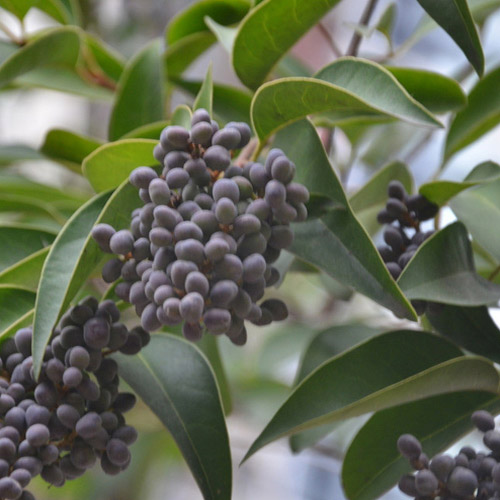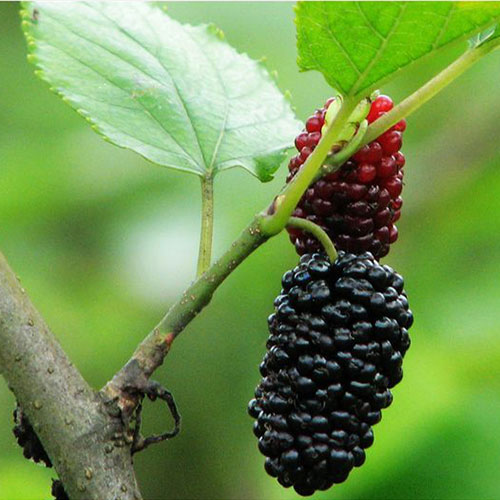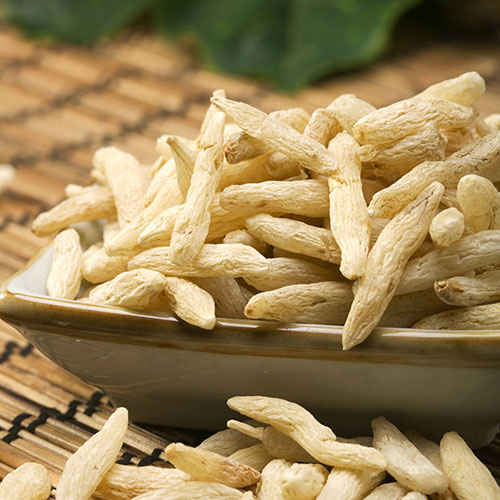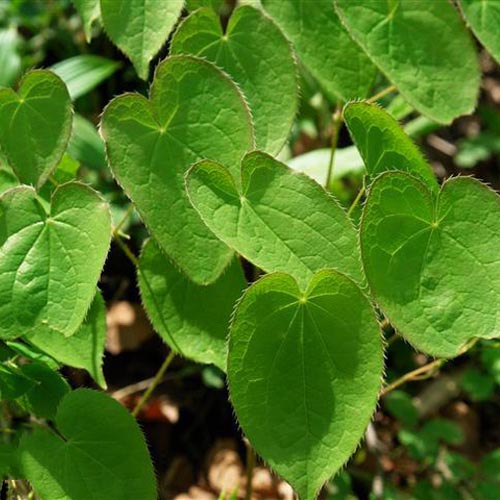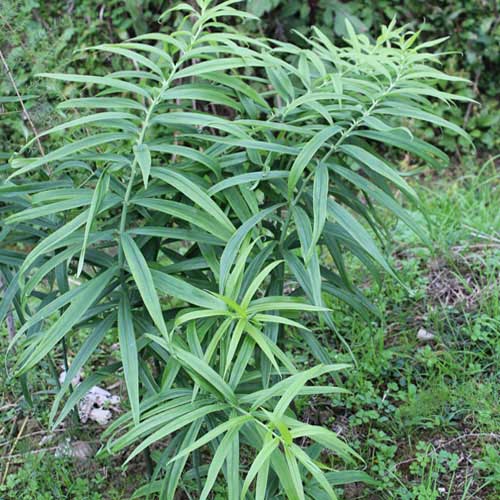- Chinese Name Nv Zhen Zi 女贞子
- Latin Name Ligustrum lucidum Ait.
- Other Names Fructus Ligustri Lucidi, Privet Fruit, Glossy Privet Berry, Ligustrum seed, Chinese Privet
- Used Part Fruit
- Specification Powdered Extract
Ligustrum Fruit Extract Powder
Description
Nu Zhen Zi – Ligustrum Fruit – Privet fruit – “Female Chastity Seed”
Traditional Use
Ligustrum Fruit is one of the oldest Chinese herbal remedies, used for over 2,000 years, at least from the time of the writing of the Divine Husbandman’s Classic of the Materia Medica in 190 BCE. It has cooling properties that are known to help the yin, and augment weakness in the liver and kidneys. Known in Chinese as the “female chastity seed,” Ligustrum Fruit was an ancient remedy for premature graying of the hair, ringing in the ear, spots before the eyes, and lower back pain, all of which were associated with excessive sexual activity.
In TCM theory, the liver opens into the eyes while the kidneys open into the ears and manifest in the hair. When there are yin deficiencies in both the liver and kidneys, the eyes and hair lack nourishment resulting in symptoms like blurred and dark vision, decreased visual acuity and early whitening of the hair. Fructus Ligustri Lucidi can invigorate and slowly nourish both liver and kidney yin making these symptoms generally associated with aging much milder.
Modern research has also found that the fatty acids in Ligustrum Fruit are especially helpful for protecting the body from contamination with heavy metals, notably arsenic and cadmium.
Chemical Constituents
Ligustrum fruit contains nuzhenide, olenropein, -hydroxy-beta-phenylethyl-beta-dglucoside, oleanolic acid, manitol, betulin, lupeol, salidroside, oleic acid, linolenic acid, palmitic acid and other fatty acids. The skin of Ligustrum fruit contains oleanolic, acetyl oleanolic acid and ursolic acids. The seed contains 14.9% lipids and the lipids contains 19.5% palmitic and stearic acids as well as 80.5% oleic and linolenic acids. Its flower bud contains manitol, rutin, luteolin-7-beta-D-glucoside, apigenin-7-beta-D-glucoside, apigenin-7-beta-D-glucoside and quercetin. The leaf contains oleanolic glycoside, 4-hydroxy-beta-phenylethyl-beta-d glucoside and ligstroside. The volatile organic content of Fructus Ligustri Lucidi contains large amounts of ester, alcohol, ether, thioketone and hydrocarbon and small amounts of amine and aldehyde.
TCM Tradition
Taste & Property Bitter, Sweet, Cool
Organ Meridians Kidney, Liver
TCM Functions
• Nourishes and tonifies Liver and Kidney Yin
– Kidney and Liver Yin Defici back soreness, premature graying of the hair and tinnitus encies with dizziness, spots before the eyes, lower
• Clears Deficiency Heat
– Yin Deficiency with Empty Fire Rising
• Improves vision
– Diminished visual acuity in those with Liver and Kidney Deficiencies
Science Research
Pharmacological Actions
1. Effect on Immune Function
Animal Studies
Mice were administered by gavage with a Fructus Ligustri Lucidi decoction at 12.5g/kg and 25g/kg (=1g/ml raw herb) for seven consecutive days. Results showed both dosages of decoction were able to increase the weights of the thymus and spleens in mouse pups. At 25g/kg, Fructus Ligustri Lucidi decoction was able to increase the weight of the spleen but not the thymus of adult mice. Similarly, an injection of 10mg/kg Fructus Ligustri Lucidi polysaccharide to mice everyday for seven days was able to increase the spleen weight by 30% (149.3 ± 13.5mg/20g vs. 110 ± 11.7mg/20g) in the control group.
Fructus Ligustri Lucidi decoction was shown to increase the activity of serum hemolysin antibody and serum IgG levels. A Fructus Ligustri Lucidi decoction of 25mg/kg counteracted the decrease in mouse serum IgG levels caused by cyclophosphamide suggesting Fructus Ligustri Lucidi may reduce the immuno-suppressive effects of cyclophosphamide.
A dose of 10mg/kg and 50mg/kg Fructus Ligustri Lucidi was able to increase the proliferation rate of ConA stimulated mouse lymphocytes by 120% and 70% respectively. When sarcoma (S180) bearing mice were injected i.p with 50mg/kg cyclophosphamide, their lymphocyte proliferation was suppressed. Further, administration of 40mg/kg Fructus Ligustri Lucidi to these mice was able to attenuate the cyclophosphamide’s immune suppressing effects.
Mice orally fed with 75mg/kg and 150mg/kg oleanolic acid for five days showed increased prostaglandins (PGE2 and PGF2α) contents in lung and kidney tissues, indicating that oleanolic acid might have stimulatory effects on cyclo-oxgenase activity. When treated with oleanic acid, mice had less histamine release than in the normal saline control group, suggesting oleanolic acid may have inhibitory effects on histamine secretion.
2. Enhancement in SOD Activity
Animal studies
Mice divided into four groups of an old aged vitamin control group, a young aged vitamin C control group, an old aged Fructus Ligustri Lucidi treatment group and a young aged Fructus Ligustri Lucidi group were treated with either a vitamin C or a Fructus Ligustri Lucidi ethanol extract (=20ml raw herb) for 40 consecutive days. Liver SOD activity was then measured. It was found that the SOD activity detected in young mice was significantly higher than that detected in old mice (0.40±0.16u/mg protein vs. 0.27±0.12u/mg protein) suggesting that SOD activity decreased as age increased. Oral administration of Fructus Ligustri Lucidi and vitamin C can increase SOD activities in old age mice livers 59% and 48% respectively.
3. Increase in White Cell Count
Animal studies
When mice were administered by gavage with a 40g/kg Fructus Ligustri Lucidi ethanol extract, cyclophosphamide induced white blood cell count reduction could be restored. Other studies also reported, Fructus Ligustri Lucidi was able to restore depressed white cell counts resulting from chemo- or radiotherapy treatments[5]. When cyclophosphamide treated mice were orally fed with Fructus Ligustri Lucidi‘s active ingredient oleanolic acid (100mg/kg) for four consecutive days, their white cell counts could be increased from 5141±434 to 6595±61. Some other reports have claimed that Fructus Ligustri Lucidi may be able to stimulate blood generation in the bone marrow.
4. Effects on Cardiovascular System
Animal studies
The alcohol solution of Fructus Ligustri Lucidi was shown to increase the coronary blood flow of isolated rabbit hearts. However, it inhibited the contractility of heart muscle and had no significant effect on heart rate. Conversely, Fructus Ligustri Lucidi extract was shown to increase the cardiac (heart) output, heart rate, aortic arterial pressure and central venous pressure of dogs.
5. Liver Protective Effect
Animal Studies
Rats were given a subcutaneous injection of oleanolic acid (one of the active ingredients of Fructus Ligustri Lucidi), at a dose of 100mg/kg and 50mg/kg for 6 days. Results showed that the serum ALT (SGPT) level decreased suggesting this active ingredient may provide protection against rat liver damage induced by CCl4 and promote the regeneration of liver cells. Oleanolic acid was also reported to reduce the triglycerides stored in the liver, alleviate the degenerative necrosis of liver cells, increase glycogen stores and lower the γ-immunoglobulin levels in the serum.
6. Hypoxia Tolerance
Animal studies
When mice were injected i.p. with 0.7ml acetic acid extract of Fructus Ligustri Lucidi leaf, they were able to survive longer in hypoxic conditions with low pressure.
7. Anti-cancer effects
Animal studies
When 60g/kg Fructus Ligustri Lucidi water extract was administered to mice with uterine cervix carcinoma, tumor growth was inhibited by 49.2%. However, the same Fructus Ligustri Lucidi treatment showed no effect on sarcoma (S180) and lymphoma (L1) cells grown in mice.
8. Toxicity
Acute toxicity: No toxic side effect was detected in rabbits fed with 75g fresh ripe fruit[7]. Mice injected i.v. with ethyl acetate extract of Fructus Ligustri Lucidi leaf showed no abnormal behavior and no death cases were reported. Dogs, weighing 15kg and injected i.v. with 50mg Fructus Ligustri Lucidi leaf extract, showed no abnormality in behavior, food consumption 24 hours after the injection. No adverse event was recorded.
Subacute toxicity: Rabbits injected i.p. with 50mg/kg Fructus Ligustri Lucidi extracts once a day for six to 12 weeks showed no abnormality in the histology of major organs.

